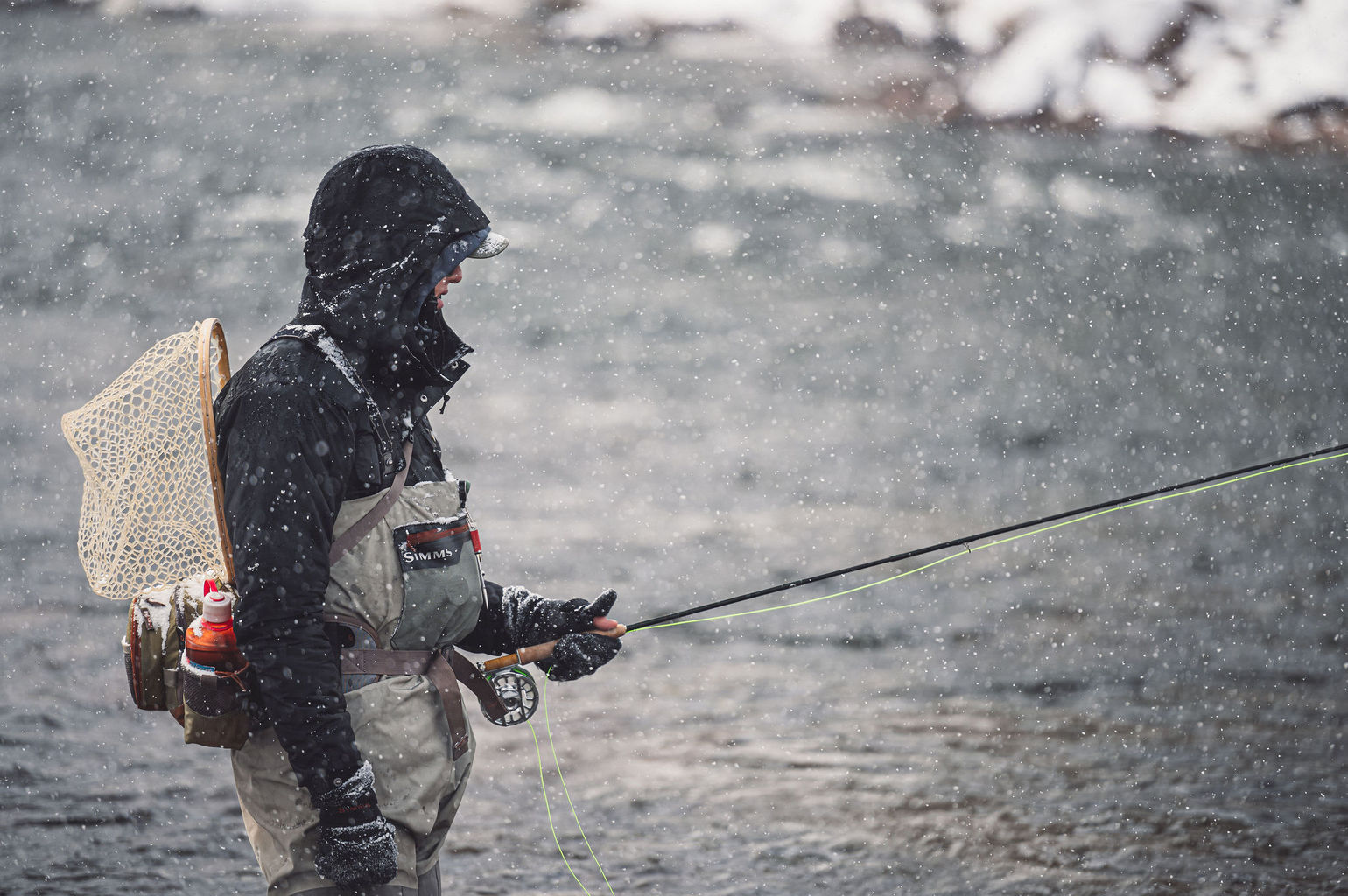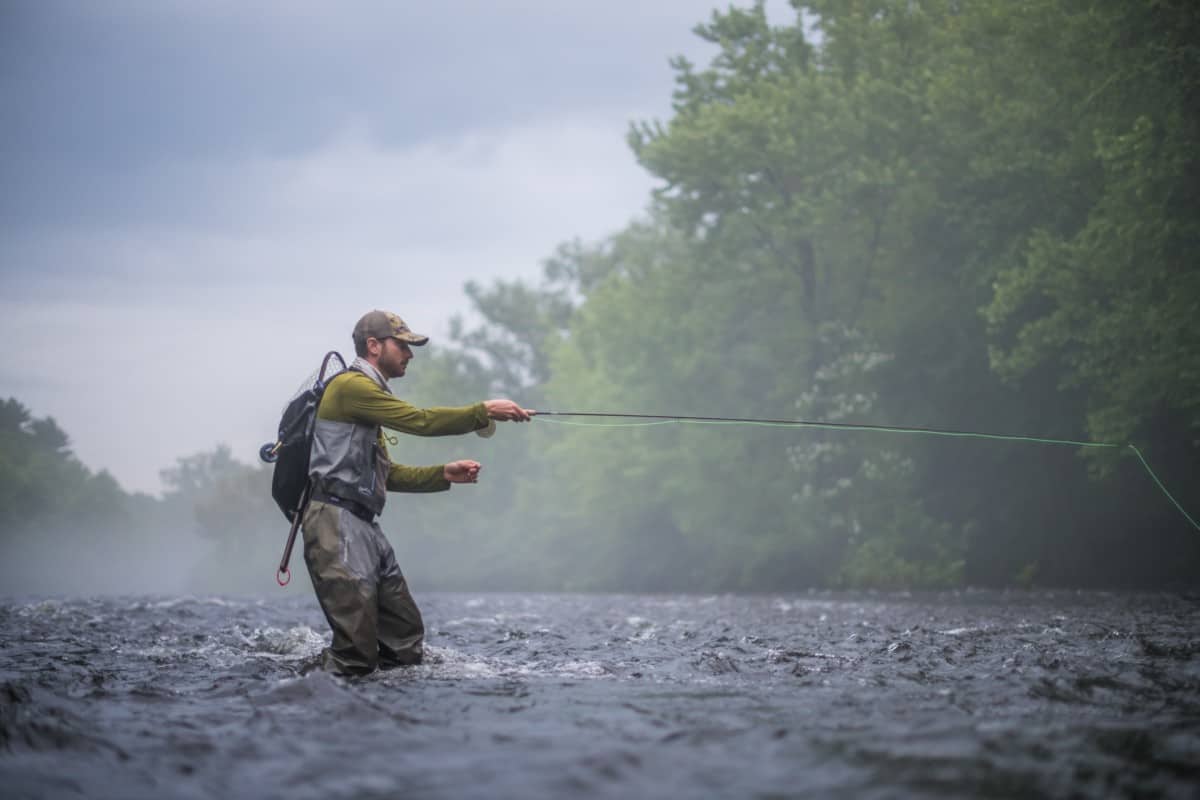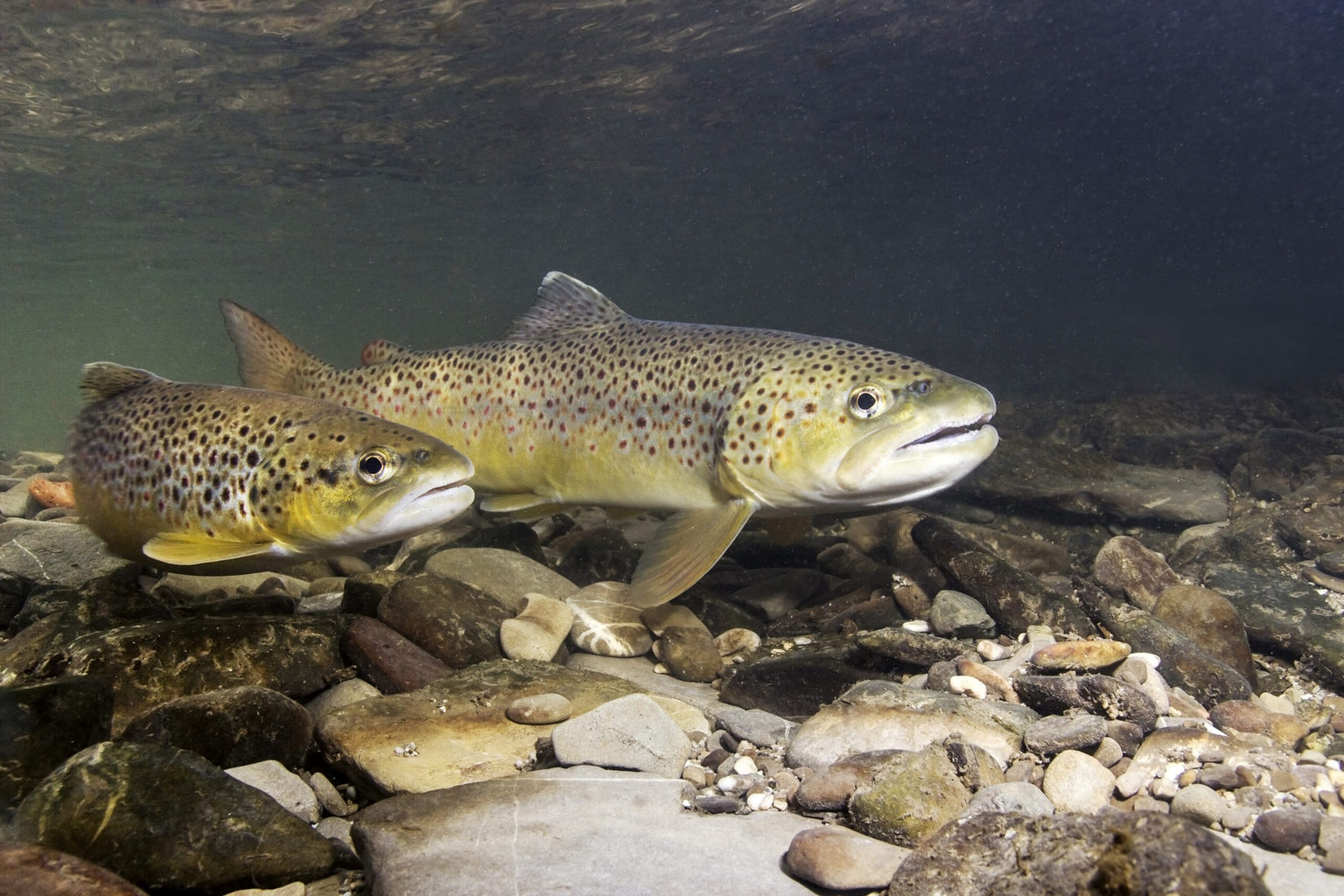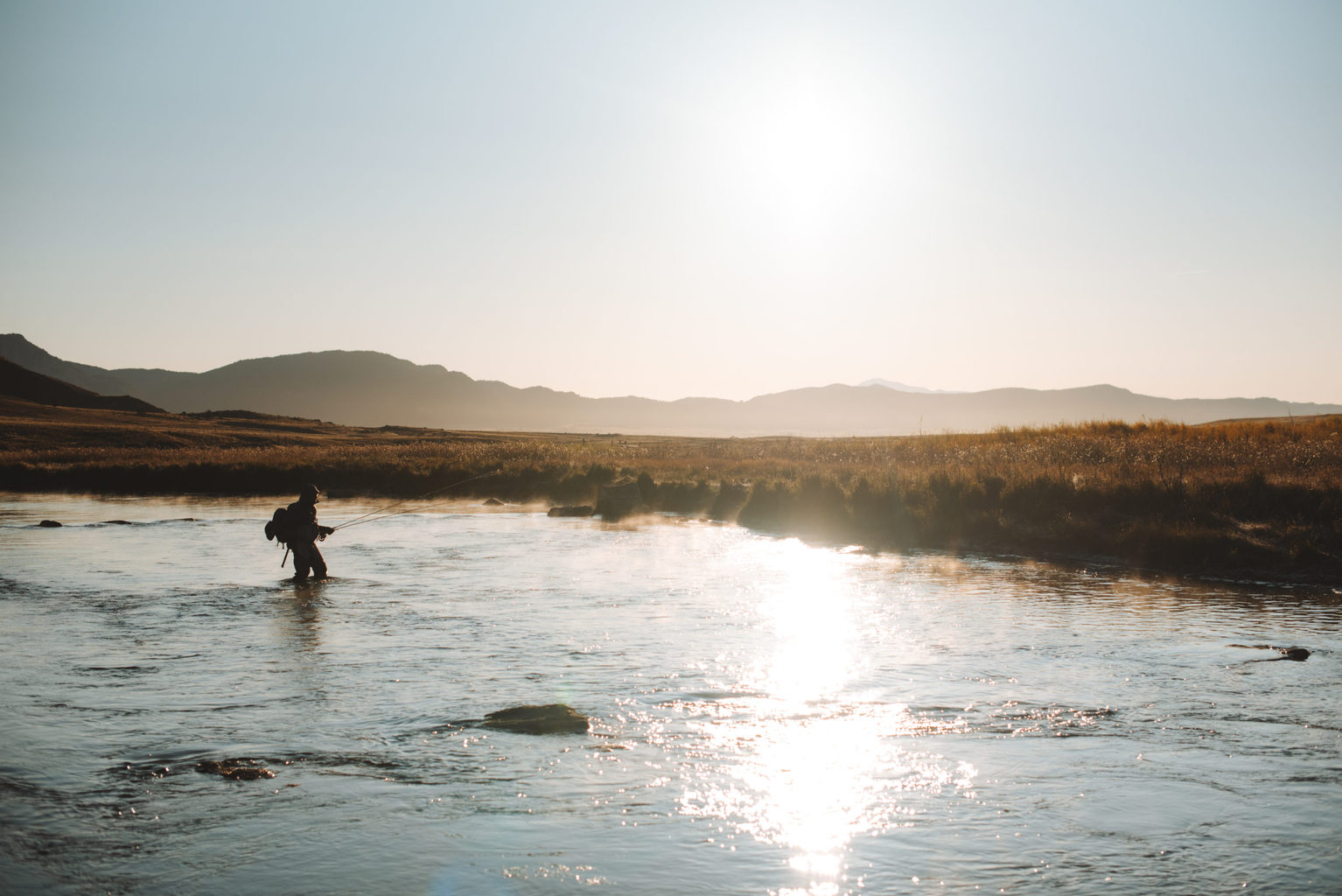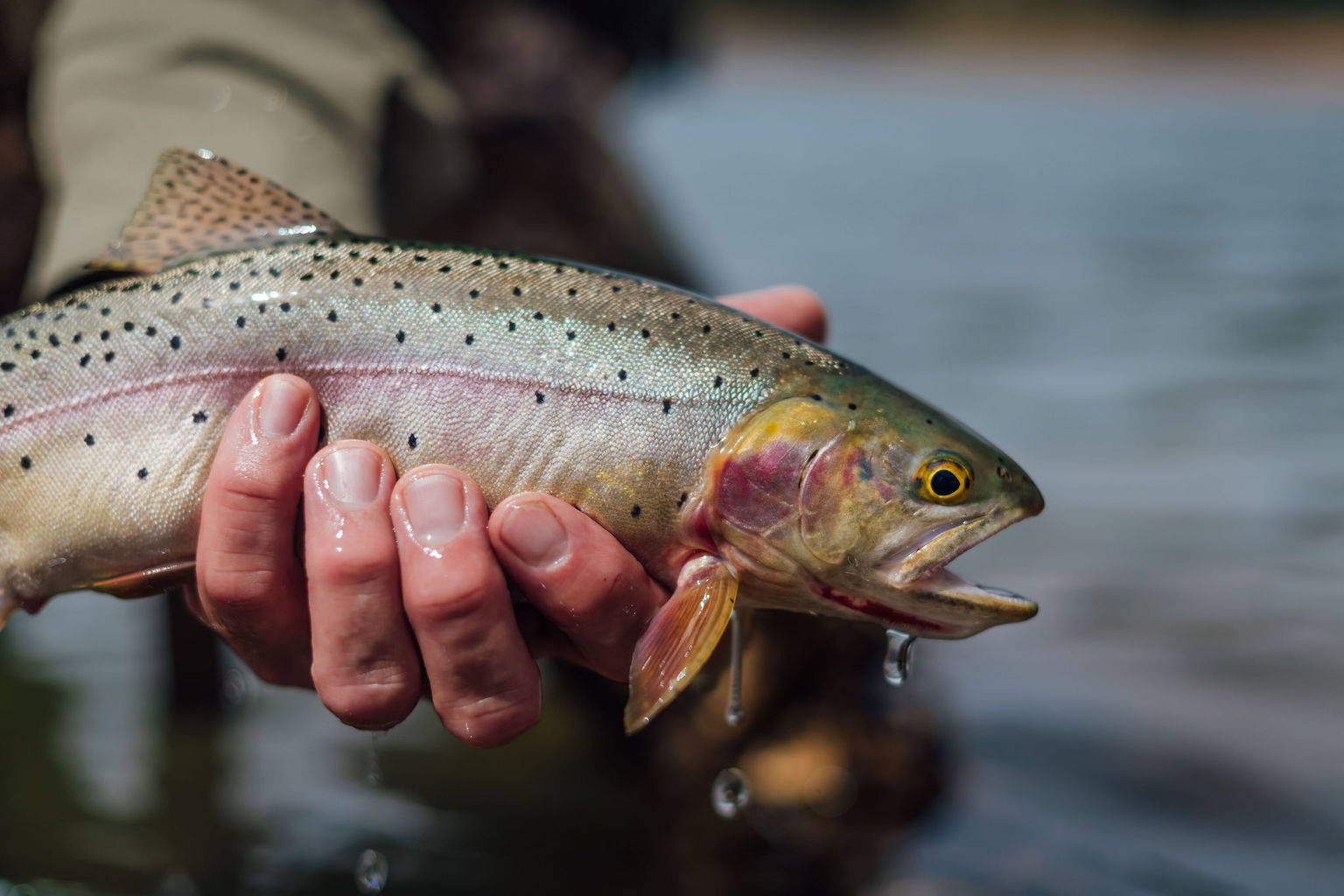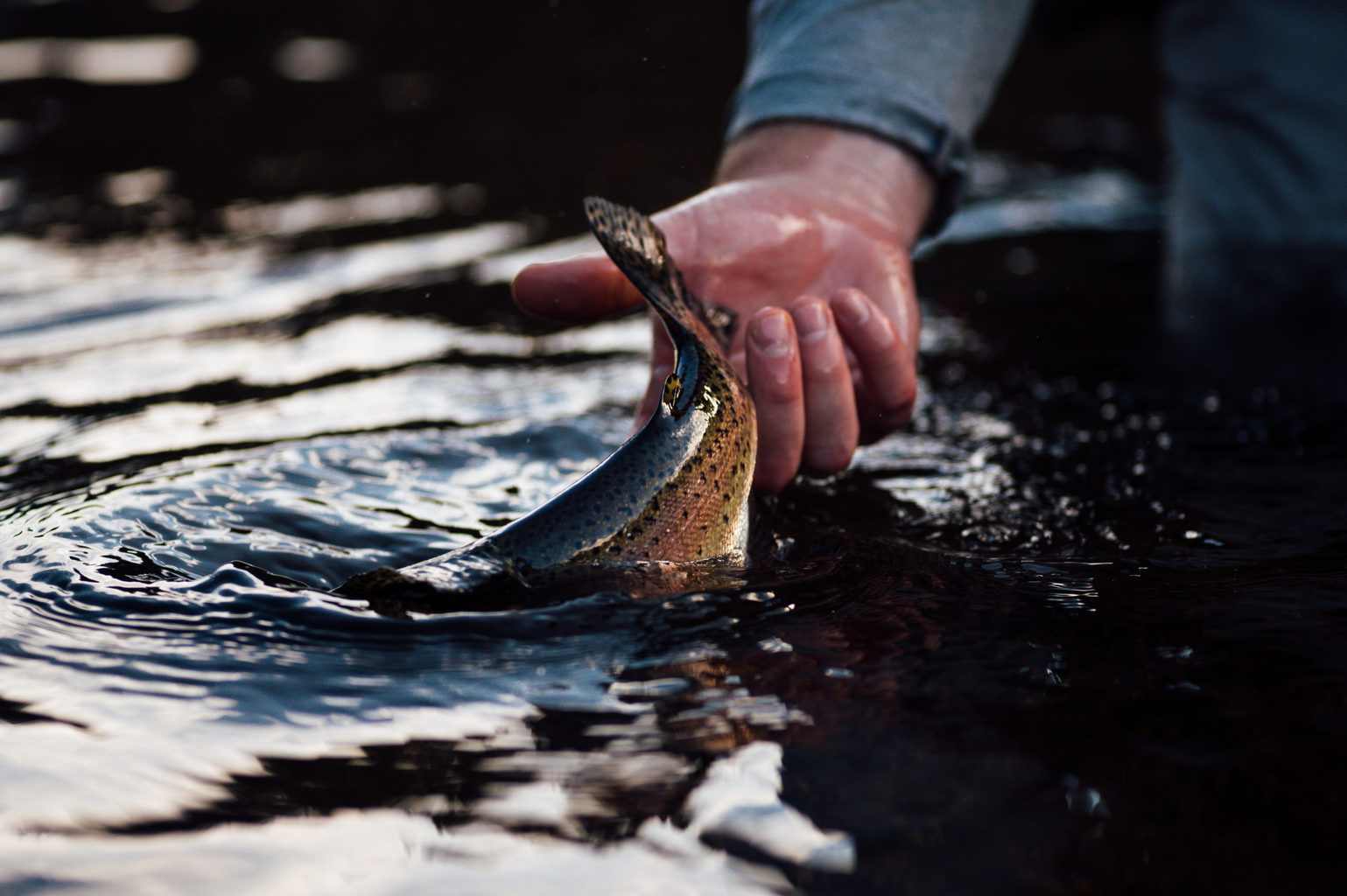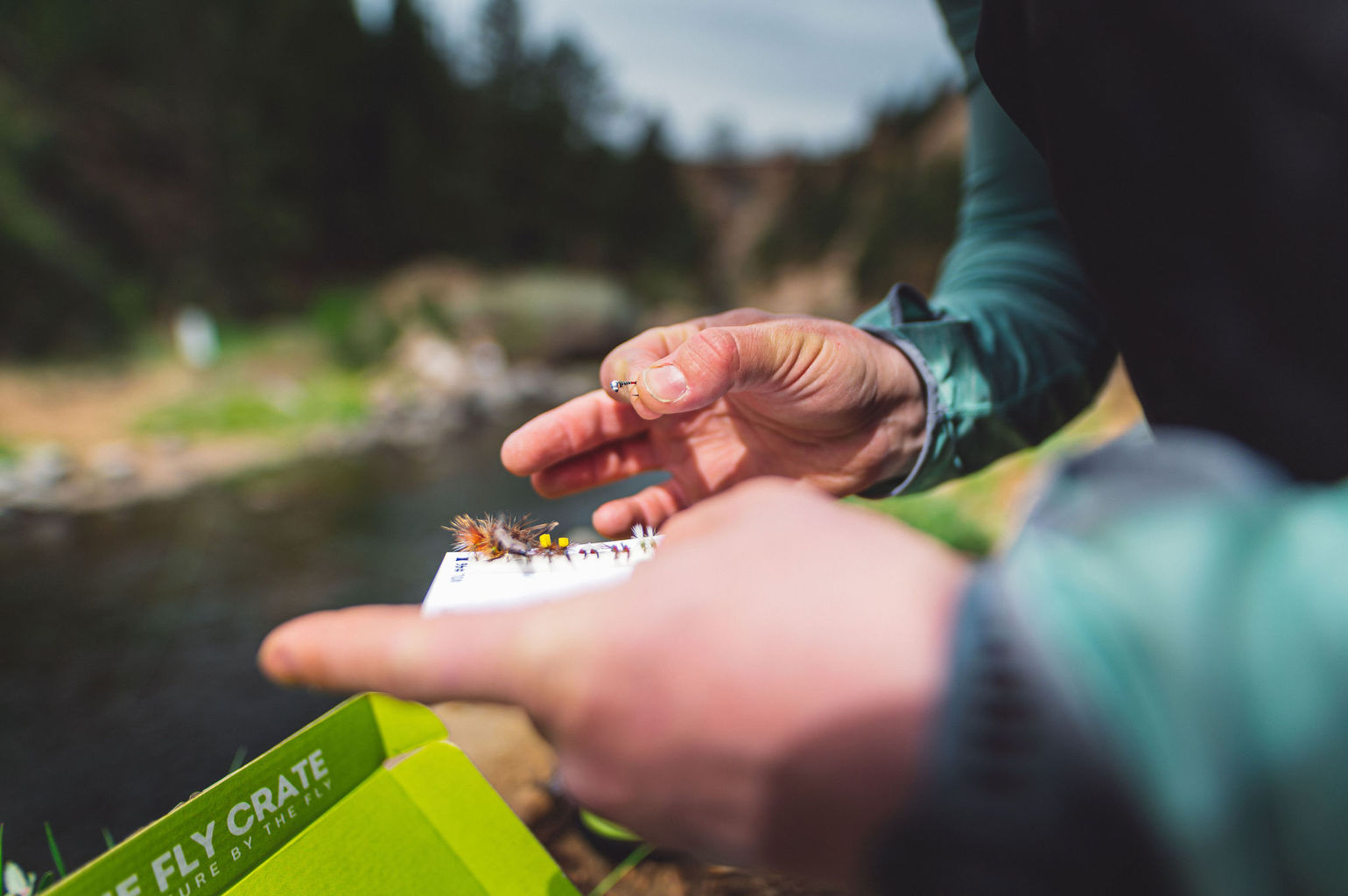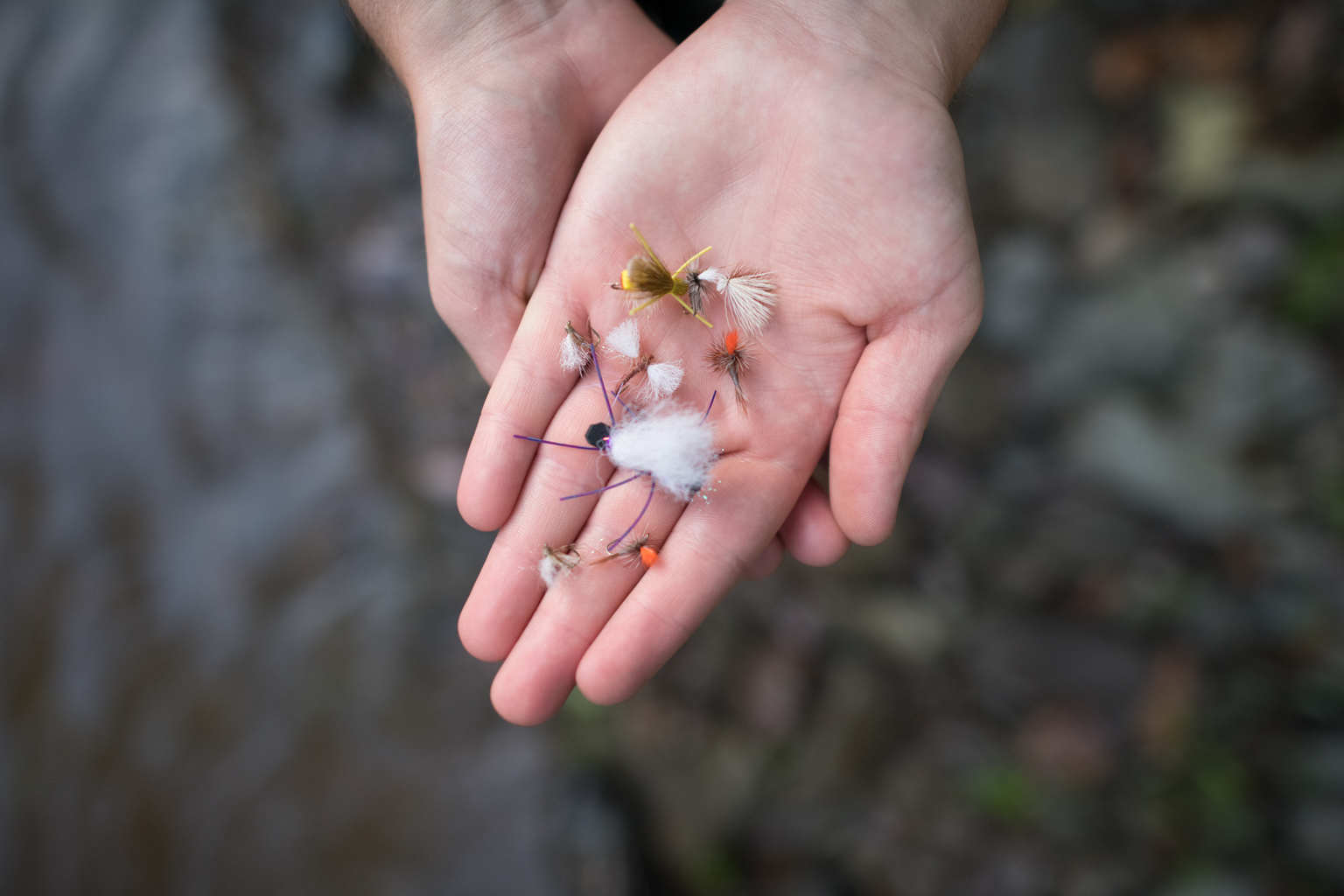How To Fly Fish Euro Nymphs: Everything You Need To Know About European Nymphing
European-style nymphing, or Euro nymphing, is a type of fly fishing that has become popular in the United States in the last decade or so. Created behind the communist iron curtain of Poland, it is a fly fishing technique born out of necessity. Euro nymphing gives anglers an efficient way to tactically approach technical water and catch selective fish in heavily pressured rivers. In this article, we will discuss euro nymphing techniques, euro nymphing rods, and a general overview of the difference between euro nymphing and traditional nymphing.
Table of contents
- What is the Difference Between Traditional Fly Fishing and Euro Nymphing?
- Why is Euro Nymphing so Effective?
- Is Euro Nymphing Easy?
- Euro Nymphing Gear
- The Advantages of a Euro Nymph Leader
- Cons to Consider When using a Euro Nymphing Leader
- A Basic Euro Nymphing Fly Setup
- Different Styles of Euro Nymphing
- The Euro Nymphing Rig – The Difference between Czech Nymphing and Polish Nymphing?
- What is French Nymphing?
- Some of Our Favorite Flies
What is the Difference Between Traditional Fly Fishing and Euro Nymphing?
Before we get into the differences between traditional nymphing and euro nymphing, it helps to understand why, where and how euro nymphing came to be. While there is some debate as to who invented euro nymphing, most people agree the Polish angler, Wladyslaw Trzebunia, father invented the technique that transformed fly fishing.
Growing up in the 60’s and 70’s behind the communist iron curtain in Poland, fly fishing rods, flies, fly lines and fly reels were almost impossible to obtain. Therefore, Trzebunia’s father invented a technique of short line nymphing that mostly eliminated the need for a fly line, fly reel, and strike indicator. Vladi, as he is known in the fly fishing world, took what he learned from his father, and further developed the method of angling. It proved to be extremely effective. In 1989, Vladi used the technique in the world fly fishing championships. He dominated the entire field, and Poland dominated the competitions for decades. The technique works everywhere.
It is a very effective way to catch fish no matter the flow or depth of water, it can be fished in any time of year, and has produces fish in both recreational and competitive fishing.

In its basic form, Euro Nymphing uses a single line, with a heavy weighted nymph at the end of the tippet. There is a sighter line between the main line and tippet. This is attached to another long piece of leader that then goes directly to the main fly line. There is no need for split shot or floating bobber indicator. The sightline helps an angler detect a strike on a tight line. This technique is about drifting a fly on a tight line, feeling the bottom with as little line contact on the water as possible.
Why is Euro Nymphing so Effective?
Understanding why Euro nymphing is so effective makes the learning curve much quicker. To understand the technique, you need to have a better understanding of what is happening under the water.
When an angler approaches a river, it is easy to see the currents that appear on the surface of the water. There are hundreds of currents both fast and small. There are even more currents that you cannot see with the naked eye. The river is a 4 dimensional space. For every current we see on the surface, there are many more that we cannot see below the surface of the river. In general, the current flowing at bottom of the river near the substrate is slower then the current at the surface. This makes logical sense. As you move higher in the water column, water has less contact with objects that impede its flow, therefore it moves at a faster speed.
Water closer to the bottom of the river is following the contour of the riverbed and is influences by the subtle changes in the rocks, debris, and depressions or rises in the river bottom. Subtle vertical or small depressions in the stream bed create slower flow. As we mentioned in previous articles, fish are keyed into the speed at which natural food sources move. Too fast and the flies are dragging un-naturally, too slow and the fish recognize an ill conceived presentation. Fishing with a foam strike indicator puts you at a disadvantage when trying to present flies deep to the bottom of the river. Drag, or the elimination of it, is an important factor that euro nymphers have diminished in an effective way.
When traditional nymphing with a strike indicator, the current on the surface of the river grabs the indicator and exerts forceful pull on the foam bobber. The indicator on the surface of the river is being pulled faster then the flies at the end of the leader. Drag is the result, and therefore less fish are caught. It is difficult to present flies deep with a strike indicator at the same speed as the deeper slower river currents.
In addition, small amounts of slack are always present in the leader when fishing with an indicator. Staying in constant contact with your flies is impossible. Strikes often go undetected.
When a trout takes a fly subsurface and deep, the strike has to travel up the leader to the indicator to telegraph to the fly fisher that a strike has occurred. Strikes happen quickly, and often times the fish has eaten and rejected fly before the strike is detected.
In a euro nymph rig, the angler holds the rod in a way that the multi colored monofilament strike detector is just above the surface of the water. There is no slack in the line, and the angler maintains a constant connection with the flies. The lighter and longer tippet length helps the flies sink quickly, and the force of the water isn’t able to drag the flies because there is nothing for it to grab on to. A euro rig leader is different than your traditional fly fishing leader.
The total leader length should be twice the rod length as a general rule of thumb. The bulk of this will tend to be the section tied directly to the fly line. The sighter tippet, which is brightly colored for contrast, is attached to this and is about two feet in length. Typically, the sighter is a bright chartreuse section and a neon red for low light and bright conditions.
At the end of the sightline a tippet ring is attached and then a piece of tippet generally about two feet long is attached. Towing the line in a very small way is your fly tied to the end of the tippet. Above that anglers will often fish a fly on a dropper. All in all, this is the total setup for Euro Nymphing.
Is Euro Nymphing Easy?
Euro nymphing is not as easy as watching a strike indicator plunge under the surface at every strike, but not by much.
However, Euro nymphing is definitely more effective and, arguably, more entertaining due to the attentive nature you need to do it effectively.
I would say that dry fly fishing is more difficult to master than euro nymphing. To start euro nymphing, you do not need to memorize the technical details that experts know to get the job done, such as bead size, bead weight, hook gaps, and leader length or thickness. Nor, do you need to be proficient at casting or mending as you do with fly fishing dry flies.
To give you an idea of a basic euro nymphing cast, it’s more swinging the weight of your fly or flies and a flick than a back-and-forth cast. When nymphing with a tight line, your leader and fly rig does not have the same thickness as a typical tapered leader you would get at the store or online. The euro leader is made up of multiple sections that vary marginally in thickness and is constructed by thin, flexible monofilament and fluorocarbon sections. It is designed for short casts and reaching into pockets.

The technique is as simple as the setup, there is no false casting, nothing bulky to bunch and tangle during your back cast, and this all helps with the other beauty of this rig, efficiency. Simply roll cast upstream at a slight angle accurately flicking your nymph flies into a riffle or seamline upstream of where you believe trout to be. Next, raise your fly rod up so that the tip is high in the air with your fly leader off the water and lead your nymphing rig with the fly rod downstream with a semi-tight line. You’re nearly dragging your nymphs downstream, however, you pace the rod at the same speed your nymphs are drifting. When your flies finally start to tail out at the end of the drift, swing it through so your fly leader swings across the currents and straightens out behind you, as it rises in the water column downstream and about even with your hip, use that tension and “roll” cast upstream again. No fuss no muss.
As long as you can “feel” the bottom or you can see subtle movement in the bright colored monofilament you’re doing it right! One of the biggest struggles is the absolute line control one must have for this technique. It’s supposed to be fun, but remember line control isn’t the place for cutting yourself some slack, pun intended.
Now that we have talked about the casting, let’s dive into the strike. When you feel or see a strike it can come as the proverbial thump, or a subtle as seeing the colored line move a fraction of an inch, or even a pause. The instant reaction is to immediately set the hook up, but in Euro Nymphing the best way to set the hook will be to note the angle of the sight line and set the hook in the opposite direction. So if the line is at a ninety degree angle then the up hook set would be correct, but if it was at any other angle you would have slack in the setup with that set, you may miss the fish or even worse break it off on the set. So , if the sight line is angled downstream, set the hook angle upstream and so on.
Euro Nymphing Gear
Now the fun part, gear! You can use any rod over about nine feet in length to Euro Nymph. Honestly, you can use any length fly rod, however, you have the greatest advantage over 9-feet. Just like any other method of fishing, there are technique specific options for euro nymphing that will help you become more effective. A good euro rod would be a 9 – 11 foot, 3 or 4 weight. The length helps keep the line off of the water, and because the flies are so small and the cast so efficient, a heavier rod is a detriment. Moreover, the tip will be very light to detect strikes.
Longer rods will give you several advantages over a shorter heavier rods. First and foremost, sensitivity is critical to feeling the heavily weighted flies tick along the bottom of the river and light strikes. Euro rods with lighter and longer rod tips help the angler to feel everything. In addition, the angler maintains a greater distance from the fish. This is critical because we are not making a normal fly cast. Euro nymphing calls for short lob cast to fish within the distance of our rod length. Essentially, dropping flies into their face and feeding a specific fish. The extra foot or two in the rod tip is a huge advantage. This is an excellent technique for sight fishing for bigger fish.
A Euro nymphing rods greater length also gives fly fishers added leverage over fish. This results in the ability to fish extra light tippet. Extra light tippet offers increased sensitivity and added stealth. The more leverage fly anglers have over the fish the more power you can exert when fighting them.
A good analogy to illustrate this point is to consider changing a tire on a car. If a nut on a car tire is stuck, you add a foot or two of pipe over the handle of a short ratchet wrench. This is called a breaker bar, and almost immediately, the added leverage will break the nut loose with little or no effort. This same physical principle works with fly rods.
I know an angler in here in Colorado who caught a 27 lb. 38 inch brown trout on a 12 ft 2 weight fly rod fishing 6X tippet. Landing fish this size on light gear is only possible because of the three extra feet of rod length on his euro nymphing rod.
The line is generally thinner than the normal weight forward fly line, the leader can last a very long time with the use of a tippet ring at the end of the sightline. Sightlines can be hand-tied with high contrast mono or purchased in a pre-made setup. Then the tippet can be of single diameter to help control the sink rate and easily replaced with the help of the tippet ring. In the end, it will look a little like this if you want to build a basic one: the thickest section of a nine-foot 4x leader trimmed and attached at the point of equal diameter to the sightline, then at the end of the two-foot sightline, a tippet ring and a two-foot section of 6-7x tippet then the fly.
The Advantages of a Euro Nymph Leader
There is a belief that European nymphing leaders result in increased hookups. This is a little deceiving because European leaders do help you catch more fish, but it is more than likely your ability to feel every little take compared to before. You could have missed 5 out of 10 hits on a traditional leader modified for nymphing compared to 9 out of 10 on the euro rig. The thickness of the line used in the European rig is much thinner and much more sensitive to movement and strikes. They also get deeper in the water column faster.
Because a European nymphing line is inherently thinner by design, they do not have as much drag or resistance when moving through the water. Therefore, your nymphs are restricted less and sink faster against the current. Another benefit of line thickness is that the presentation is more natural and drifts freely within the current rather than being unnaturally stiff.
While Euro nymphing leaders provide more sensitivity to the point where you can literally feel the nymph dragging, banging against the bottom, and every strike, your ability to see in low and bright light situations only increases your chances. Euro nymphing leaders, typically, have a section of neon green and neon red built into the lower section of the leader. This provides a distinguishable indicator for strikes when the line goes from having a small amount of slack to a tight, resisting line.
We usually add a section of fluorocarbon as the tippet to tie our nymphs to extending from the smooth edges of the tippet ring. In our worst-case scenario, snagging on something and needing to snap it off, we can be back to fishing within a minute or two after tying new sections on and a new set of flies. Otherwise, we can quickly switch out flies or entire rigs with a simple clinch knot to the ring.
Cons to Consider When using a Euro Nymphing Leader
Euro nymphing rigs are prohibited over a certain leader length in the artificial fly-only sections — depending on state and local regulations. In many cases, commissioners have taken out a measuring tape to measure leaders if they feel it may be too comparable to monofilament conventional tackle lines.
Additionally, euro nymphing leaders are more difficult to cast as the thickness and stiffness of lines you’re used to fishing will not be present. However, this is by design as tight-line nymphing is not meant to reach more than 2x your fly rod length. With euro nymphing leaders, you’re largely swinging the weight of your flies and relying less on the weight of your line to cast.
Recommended Reading: Why Should I Use A Euro Leader?

A Basic Euro Nymphing Fly Setup
The flies on the end can vary greatly or be a very simple system. In general, the flies will be compact, tungsten weighted, wide gap nymphs. The sizes I would start with would be in the 10-16# size. Most of the time the bottom fly will be compact, not many appendages or hackle, maybe hard-bodied and a touch smaller in profile than the dropper fly. The dropper fly should have a bit more bulk to get higher in the water. Some popular patterns are perdigons, barbless jigs, frenchies, and micro buggers. Don’t be afraid to try any heavily weighted nymph in this technique, just try to remember that the bottom fly needs to be dense and compact in comparison to the dropper.
It is critical when choosing your point fly, or bottom fly, that you fish something that bounces off the bottom of the river, gets the flies to depth quickly, and rides hook point up. The point fly is important because it is essentially your strike indicator. It helps the angler maintain contact at all times with the bottom of the river. It takes some practice, but choosing flies in various weights that match the conditions of the speed and depth of the water is key. Too heavy and it will snag in the rocks. Too light and you lose contact with the river bottom.
One of my favorite point flies is the condom fly. I have never seen this pattern tied commercially. When Vlad was inventing Euro nymphing behind the iron curtain, one of the few fly tying materials available was pink latex condoms. Using creativity, he wrapped it around a heavily lead weighted English bait hook. Tying different sizes of these flies in different weights allows an angler to present the flies at different depths and in varying water conditions. This is one of my favorite flies to use as a point fly Euro nymphing.
Other commercially available flies that work excellent as point flies are jig head Pat’s Rubber Leg’s, Squirmy Worms, and of course the mop fly. The fly combinations are endless.
Here’s one of our go-to euro rigs:
1. Frenchie Jig
2. Perdigon
3. (Point Fly) Large Mop Fly
The mop fly is one of the most effective fly patterns in fly fishing. I couldn’t tell you why it works so well, but it excels at catching fish. I incorporate the mop fly into my fly fishing rigs no matter whether I am fishing under an indicator or euro nymphing. A large mop fly as the point fly will also catch bigger fish in my experience.
Different Styles of Euro Nymphing
European nymph fishing was developed and utilized in international fly fishing competitions. Therefore, many different versions of tactical nymphing have been developed by different countries over the years. Different spins on the same technique have developed over the years. You will hear different variations on this style of nymphing often referred to by the countries that took the original method developed in Eastern Europe and added their own twist to it.
This can be all very confusing, there are major and minor nuances to each of these techniques that set them apart, but are all effective trout fishing techniques. The question, “What is the difference between all the techniques?”, is a common one.
We will discuss the differences between French/Spanish nymphing and Polish or Czech nymphing. You can split these techniques into two general categories: Short line nymphing and long-line nymphing. Polish and Czech nymphing use short lines, and Spanish/French nymphing utilizes long line nymphing.
No matter which version we are discussing, they all have several points of commonality: they are used in competitions and are best fished with longer rods. Competition rules state that you are not allowed to use a traditional strike indicator or add split shot or exposed lead wire to your flies or leader. Therefore, euro nymphing flies are often heavily weighted flies tied on jig style hooks to get to depth quickly. No matter what style of presentation you choose, the flies outlined in this article will work well for trout fishing. In addition, all of these styles of fishing call for the use of a longer rod tip. We will go over the finer points of different styles of European nymphing and do our best to demystify them.
All of these methods when nymphing are extremely effective when done well. This is evident in the number of international titles won by Euro nymphing teams, and the increased popularity of this style of fly fishing.
It should be noted too that these techniques can be performed with a standard 9 ft trout rod and weight forward fly lines. Don’t let the technicality of the rigs stop you from trying different techniques. I was fishing the Blue River in Silverthorne many years ago. There was a giant pod of trout sitting on the bottom of the river. For hours I watched angler after angler and guide after guide drift indicators over the group without a single fish caught. When it was my turn, I decided to try Euro nymphing for the first time. I changed rigs with a very basic knowledge of what I was doing. The next hour, produced 30 or so trout. The change in tactic and presentation paid off handsomely. It pays to try new things!
The Euro Nymphing Rig – The Difference between Czech Nymphing and Polish Nymphing?
In short, the principles are the same. Both techniques utilize a presentation in such a way that the angler maintains a short lob cast upstream, a multi-colored section is used as a sighter to detect strikes. The main difference between the two is the leader setup and the fly selection.
Czech nymphing can utilize either two or three flies tied on tag ends. Traditional flies normally considered Czech nymphs are either small shrimp flies, or variations of sedge larvae. A Czech Nymph’s appearance is very similar to traditional scud patterns.
When fishing a Czech nymph leader with three flies, the heaviest fly is added to the middle of the leader, or it is usually the second fly. The reason the heaviest fly is put in the middle of the leader is so that the weight of the fly drags the other flies down deep in the most expeditious manner.
The Polish version is very similar. The main difference is that the leader uses the heaviest fly as the point fly. The heaviest fly tied to the end of the leader allows the angler to maintain a tight connection to the fly as it bounces along the bottom of the river. This is basically a reverse strike indicator. The angler uses the contact of the bottom of the river to detect strikes and move the fly along with the slower bottom currents of the river’s streambed. Heavily tied mop flies or squirmy worms are effective for this. If you are fly tier, then a condom fly is an excellent addition to the fly box. The French and Spanish took these methods and made them their own.
What is French Nymphing?
French nymphing, A.K.A. Spanish nymphing, is long line nymphing. French nymphing uses long, thin leaders to achieve a proper presentation. While Polish and Czech euro nymph rigs use leaders that are a few feet to 8 feet in length, a French leader uses long leaders that are 16′ to 30′ feet in length. A French leader can be changed in length depending on the situation.
French nymphing was developed for fishing to heavily pressured fish in the mountains of Europe. In that part of the world, there are less fish and they are heavily pressured. They spook easily. Maintaining a long distance from the fish is critical. The longer tapered leader with extended tippet length aids anglers in creating distance from weary fish.
There are many different ways to create a French leader. Long leaders with stiff mono are key. The first section of the tippet can be 25 lb to 20 lb. test mono. Next, a sighter is tied into rig. The sighter is a coiled piece of mono that is similar in appearance to a spring. From there, ultra fine tippet is used in 6X or 7X to make up the final portion of a French leader. It is possible to fish both a single or multi-fly setup. Any fly can be used. Flies fished in a French nymphing scenario are usually on the smaller side. Standard jig head flies, dries, and even traditional sedge like Czech nymphs can be fished.
While strike indicators are not allowed in competition, a colored sighter is used, tied halfway into in the leader, and fished just above the water. A French sigher is typically an according looking piece of heavy mono. Tied into the nymph rig it is an extremely sensitive strike indicator. You can detect the most delicate of strikes. While you can buy these indicators online, they are easy to make. Utilizing a heavy piece of mono, preferably colored, wrap it tightly around a pen or pencil. Place it in the freezer, and leave it overnight. The result will be tightly coiled according piece of mono with a ton of memory. Don’t forget to leave a few extra inches on each end of the indicator. You will need to tie this into the leader. You can attach it by using two non slip loops on each end. Connect it to rest of the leader with handshake knots.
A tight line presentation is key. Unlike the Polish technique, where the angler makes a short lob cast upstream, this rig can be cast. The absence of a weighted fly line makes casting a long leader difficult for beginners. However, with some practice, the presentation can be achieved. A rod with an extra slow rod tip makes it possible the cast the flies in an effective manner without the weight of the heavy fly line.
French nymphing rods are typically 11-12 feet. This enables the angler to keep the line off the water and maintain contact with the flies at all time. This is critical when mastering the French nymphing technique.
A French nymph rig can be fished with a quartering presentation upstream or downstream. Nymphs and dry flies are both utilized in this rig. I have used French nymph fishing techniques when fishing for cutthroat trout rising on gravel bars to P.M.D.’s. Maintaining an upstream position of fish, I used the long rod and leader to present the flies quartering downstream and into the feeding lane of rising fish. Feeding fish in this manner, with a delicate presentation has worked well for me.
Some of Our Favorite Flies

Size 12 – 18
This competition style euro fly is designed to penetrate the water quickly and get down to the strike zone and keep them in the strike zone. Tied with dense steel hooks and tungsten beads, they drop fast into feeding lanes. These flies feature a barbless hook and a very long claw point. Even without the barb, the elongated claw point helps you hook nearly every fish and hold them on firmly. Minimizing the handling of fish is important as well. Barbless hooks allow you to release a trout swiftly without doing any major harm to it.

Size 12 – 20
Perdigons are hard-body nymphs with a clear coat of epoxy encasing the entire fly for added weight and increased durability. The great thing about these flies is how quickly they dive and how long they hold up. Most Euro, Czech, Tight-Line nymphing anglers have a wide variety of colors and bead sizes.

3. Frenchie Jig
Size 12 – 18
An excellent all-purpose nymph pattern that features a long gap tactical jig hook for better hookups and improved euro nymphing. European nymphers needed flies that would ride along the bottom without getting snagged. We, typically, pair this Frenchie Jig with a perdigon with a thin euro leader.

Size 12 – 18
The fluffy CDC collar and tungsten bead make this an absolutely perfect pocket water nymph and tactical pattern for euro-nymphing. We discovered the effectiveness of this pattern in the Rockies. Coupled with a double tungsten stonefly pattern tied in below, the Tactical Tag Jig does wonders in high flows.

Size 12 – 18
Rather than imitate naturals, this pattern is an attractor fly, which is designed to grab and hold a fish’s attention. In my own nymphing rigs, I either fish this single or coupled with another fly or two. When paired with another fly, I always make sure to put this nymph at the bottom of the rig.

Size 12 – 16
A hot flashy nymph for fast and deep pools. As it is a jigged nymph, you can let the Hot Headed fly roll along the bottom with fewer risks of snags. Start by focusing your casts within fast currents that run directly into long, deep riffles. More importantly, because takes will be subtle, use a small visual indicator.


Size 12 – 16
This jigged nymph is amazing for two reasons, 1. it has tons of flash and 2. it offers lots of movement. Typically, we pair this pattern with smaller flies like a midge nymph or pupa to cover the entire water column. As a heavier jig nymph we throw this at the bottom of nymph rigs so it can drag the other flies down through fast flows.

Size 12 – 16
For every fish that’s caught matching the hatch, there might be five more that are caught using a solid attractor nymph. Enter the B Smo’s Deep Purple. The curved jigged hook and rugged body make it perfect for tumbling freestone streams and wild trout. With its flashy purple body and tungsten bead, it gets down deep and grabs the attention of trout. We love to use this pattern as a prospecting fly to see where trout are holding.

9. Tungsten Jig American Grannom
Size 14 – 16
We love this pattern for streams that have high populations of net-spinning caddisfly larva. Lift up a few rocks and check your local streams. They are naturally a bright green color and net themselves against rocks in fast flow water.



10. Walt’s Worm Jig
Size 12 – 18
There’s something about simplicity that drives trout wild! It’s a slender pattern that’s built for sinking quick and this pattern is a staple among anglers from both the East and the West. On freestone streams with quick drifts and narrow windows, this is a fly to have. It has just enough flash for attracting and just a hint of a natural’s body to fool over-fished trout.

Size 14 – 18
If the looks of this fly don’t get you ready for warmer weather and swarms of mayflies nothing will! The prominent tail and two-toned head signify the always productive PMD (Pale Morning Dun), and fishers across the country have multiple versions of this classic in their fly box for good reason.


12. Tungsten Woolly Bugger Jig
Size 8 – 14
These micro streamers are an absolute favorite as a lead fly in our nymphing rigs. It has a hefty tungsten bead and a large hook gap for solid hook-ups. As an added bonus, the marabou give this streamer some great movement as you tight-line nymph this or, if you choose to, jig it across the current.


13. Worm Jigs
Size 12 – 14
Here is another suggestion for your anchor flies. Add this heavy-duty worm on the end of your nymph rigs for a fast dive to the bottom. The rubbery tail adds plenty of movement as it tumbles across the bottom and you can practically feel it’s tungsten bead slamming into every rock.
Fly Fishing Made Easy 👍
Our Quarterly Fly Club ships 1,000’s of flies to anglers all across the United States. Receive curated fly assortments selected for the season with in-depth articles on how to fish them. Great for beginners to learn and for intermediates to discover new flies.




